1996 CHEVROLET TAHOE engine overheat
[x] Cancel search: engine overheatPage 2 of 403
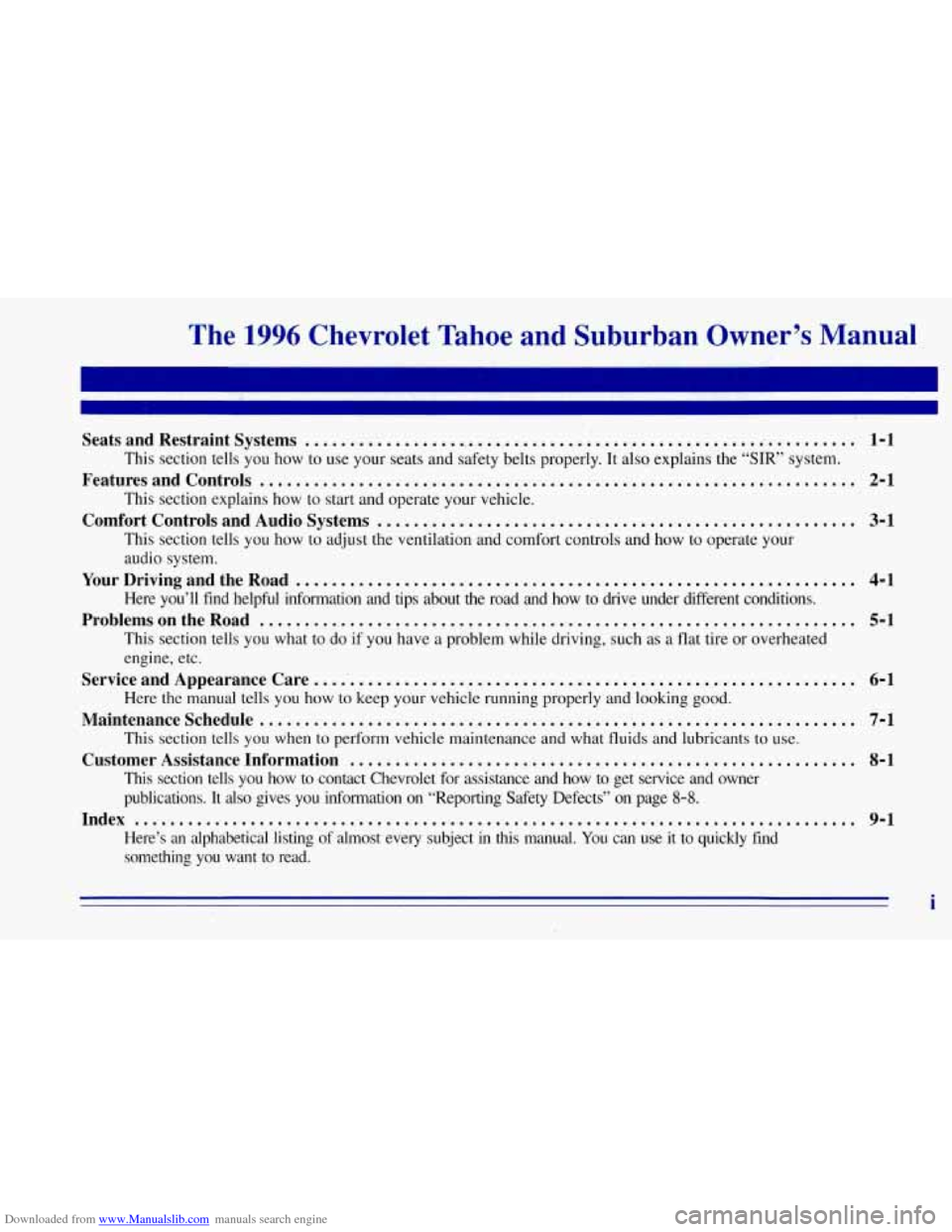
Downloaded from www.Manualslib.com manuals search engine The 1996 Chevrolet Tahoe and Suburban Owner’s Manual
Seats and Restraint Systems ............................................................... 1-1
This section tells you how to use your seats and safety belts\
properly. It also explains the “SIR’ system.
FeaturesandControls .................................................................. 2-1
This section explains how to start and operate your vehicle.
Comfort Controls and Audio Systems ..................................................... 3-1
This section tells you how to adjust the ventilation and comfort controls and how to operate \
your
audio system.
Here you’ll find helpful infomation and tips about the road \
and how to drive under different conditions.
This section tells you what to
do if you have a problem while driving, such as a flat tire or overheat\
ed
engine, etc.
Here
the manual tells you how to keep your vehicle running properly and\
looking good.
This section tells you when
to perform vehicle maintenance and what fluids and lubricants to u\
se.
This section tells you how
to contact Chevrolet for assistance ahd how to get service and ow\
ner
publications. It also gives you, information on “Reporting Sa\
fety Defects’’ on page
8-8.
Here’s an alphabetical listing of almost every subject in this manual. You can use it to quickly find
something
you want to read.
YourDrivingandtheRoad .............................................................. 4-1
ProblemsontheRoad ................................................................... 5-1
Service and Appearance Care ... .’. ....................................................... 6-1
Maintenanceschedule..................... ............................................. 7-1
Customer Assistance Information ........................................................ 8-1
Index ........................................................................\
........ 9-1
i
Page 76 of 403

Downloaded from www.Manualslib.com manuals search engine To use the coolant heater:
1. Turn off the engine.
2. Open the hood and unwrap the electrical cord.
3. Plug it into a normal, grounded 110-volt AC outlet.
4 CAUTION:
Plugging the cord into an ungrounded outlet
could cause an electrical shock. Also, the wrong
kind
of extension cord could overheat and cause
a fire. You could be seriously injured. Plug the
cord into
a properly grounded three-prong
110-volt
AC outlet. If the cord won’t reach, use ,a
heavy-duty three-prong extension cord rated
for
at least 15 amps.
4. After you’ve used the coolant heater, be sure to
store the cord as it was before to keep it away
from moving engine parts.
If you don’t, it could .@
be damaged.
How long should you keep the coolant heater plugged
in? The answer depknds
on the outside temperature, the
kind
of oil you have, and some other things. Instead of
trying to list everything here, we ask that you contact
your
GM dealer in the area where you’ll be parking your
vehicle. The dealer can give you the best advice for that
particular area.
Page 79 of 403
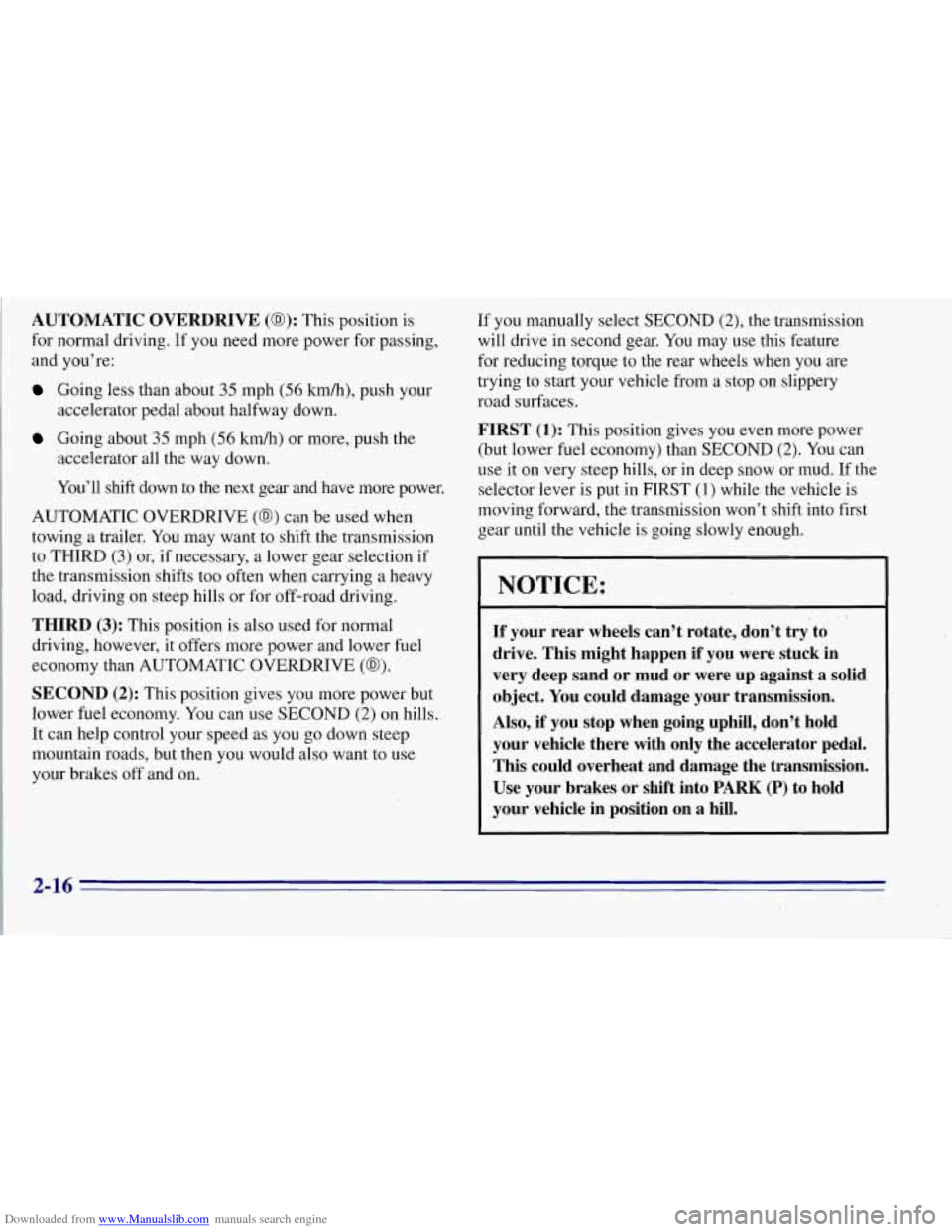
Downloaded from www.Manualslib.com manuals search engine AUTOMATIC OVERDRIVE (@): This position is
for normal dri,ving. If you need more power for passing,
and you’re:
Going less than about 35 mph (56 M), push your
accelerator pedal about halfway down.
accelerator all the way down.
You’ll shift down to the next gear and have more power.
Going about 35 mph (56 M) or more, push the
AUTOMATIC OVERDRIVE
(@) can be used when
towing a trailer. You may want
to shift the transmission
to THIRD (3) or, if necessary, a lower gear selection if
the transmission shifts too often when carrying a heavy
load, driving on steep hills or for off-road driving.
THIRD (3): This position is also used for normal
driving, however, it offers more power and lower fuel
economy than AUTOMATIC OVERDRIVE
(@).
SECOND (2): This position gives you more power but
lower fuel economy. You can use SECOND
(2) on hills.
It can help control your speed as you
go down steep
mountain roads, but then you would also want to use
your brakes off and on. If
you manually select
SECOND (2), the transmission
will drive in second gear. You may use this feature
for reducing torque to the rear wheels when
you are
trying to start your vehicle from a stop on slippery
road surfaces.
FIRST (1): This position gives you even more power
(but lower fuel economy) than SECOND
(2). You can
use it on very steep hills, or in deep snow or mud. If the
selector lever is put in FIRST
(1) while the vehicle is
moving forward, the transmission won’t shift into first
gear until the vehicle is going slowly enough.
NOTICE:
I,
If your rear wheels can’t rotate, don’t try to
drive. This might happen if you were stuck in
very deep sand or
mud or were up against a solid
object. You could damage your transmission.
Also, if you stop when going uphill, don’t hold your vehicle there with only the accelerator pedal. This could overheat and damage the transmission.
Use your brakes or shift into PARK (P) to hold
your vehicle in position on a hill.
2-16
Page 84 of 403
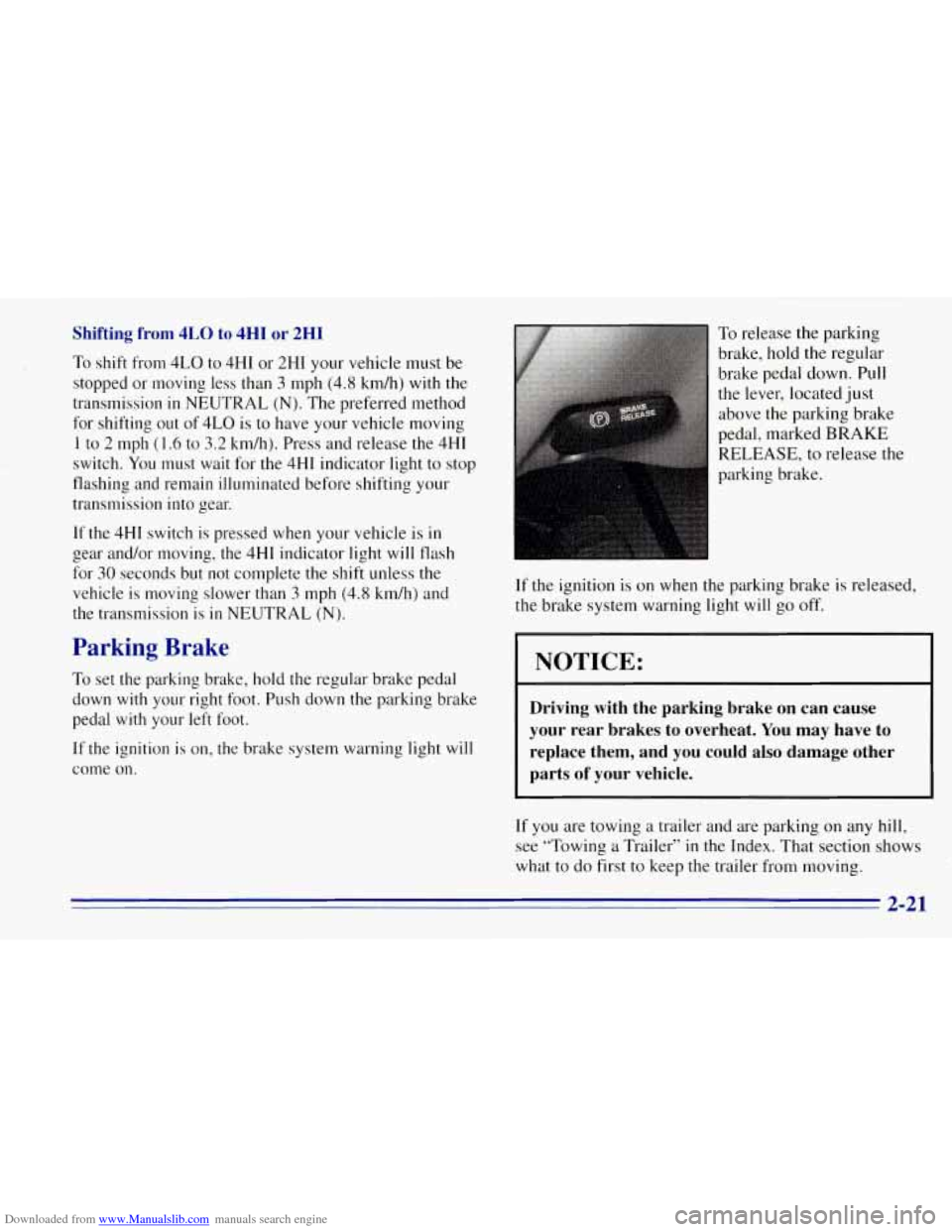
Downloaded from www.Manualslib.com manuals search engine Shifting from 4LO to 4HI or 2HI
To shift from 4LO to 4HI or 2HI your vehicle must be
stopped or moving less than
3 mph (4.8 kdh) with the
transmission
in NEUTRAL (N). The preferred method
for shifting out of 4LO is to have your vehicle moving
1 to 2 mph (1.6 to 3.2 kdh). Press and release the 4HI
switch.
You must wait for the 4HI indicator light to stop
flashing and remain illuminated before shifting your
transmission into gear.
If the 4HI switch is pressed when your vehicle is in
gear and/or moving, the 4HI indicator light
will flash
for
30 seconds but not complete the shift unless the
vehicle is moving slower than
3 mph (4.8 kdh) and
the transmission is
in NEUTRAL (N).
Parking Brake
To set the parking brake, hold the regular brake pedal
down
with your right foot. Push down the parking brake
pedal with your left foot.
If the ignition
is on, the brake system warning light will
come on.
To release the parking
brake, hold the regular
brake pedal down. Pull
the lever, located just
above the parking brake
pedal, marked
BRAKE
RELEASE, to release the
parking brake.
If the ignition is on when the parking brake is released,
the brake system warning light will
go off.
NOTICE:
Driving with the parking brake on can cause
your rear brakes to overheat. You may have to
replace them, and you could also damage other
parts
of your vehicle.
If you are towing a trailer and are parking on any hill,
see “Towing a Trailer” in the Index. That section
shows
what to do first to keep the trailer from moving.
2-21
Page 86 of 403
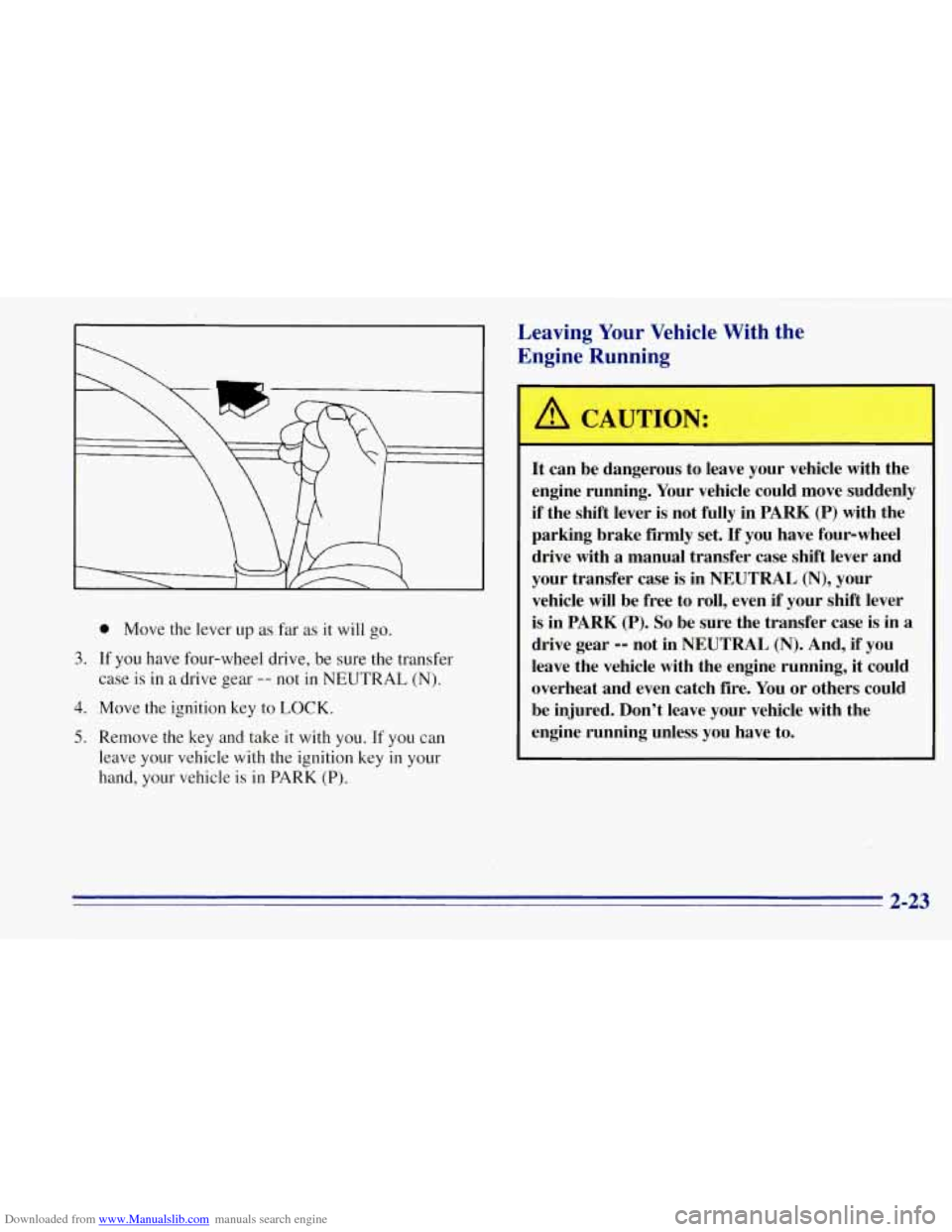
Downloaded from www.Manualslib.com manuals search engine 0 Move the lever up as far as it will go.
3. If you have four-wheel drive, be sure the transfer
case is in a drive gear
-- not in NEUTRAL (N).
4. Move the ignition key to LOCK.
5. Remove the key and take it with you. If you can
leave your vehicle with the ignition key
in your
hand, your vehicle is in PARK (P).
Leaving Your Vehicle With the
Engine Running
A LAUTION:
It can be dangerous to leave your vehicle with the
engine running.
Your vehicle could move suddenly
if the shift lever is not fully in PARK
(P) with the
parking brake
firmly set. If you have four-wheel
drive with
a manual transfer case shift lever and
your transfer case is in
NEUTRAL (N), your
vehicle will be free to roll, even
if your shift lever
is in PARK (P).
So be sure the transfer case is in a
drive gear -- not in NEUTRAL (N). And, if you
leave the vehicle with the engine running, it could
overheat and even catch fire.
You or others could
be injured. Don’t leave your vehicle with the
engine running unless you have to.
2-23
Page 94 of 403

Downloaded from www.Manualslib.com manuals search engine Remember that damaged wiper blades may prevent you
from seeing well enough to drive safely. To avoid
damage, be sure to clear ice and snow from the wiper
blades before using them. If they are frozen to the
windshield, carefully loosen or thaw them. If your blades
do become damaged, get new blades or blade inserts.
Heavy snow or ice can overload your wipers. The
windshield wiper motor is protected from overload by a
circuit breaker and a fuse. If
the motor overheats due to
heavy snow, etc., the wiper will stop until the motor
cools. Although the circuit is protected from electrical
overload, overload due to heavy snow, etc. may cause
wiper linkage damage. Always clear ice and heavy snow
from the windshield before using your windshield wipers.
Windshield Washer
At the top of the lever,
there’s
a paddle with the
word
PUSH on it. To spray
-washer fluid
on the
windshield, push the paddle.
In freezing weather, don’t use your washer until
the windshield is warmed. Otherwise the washer,
fluid can form ice on the windshield, blocking
your vision.
Washer fluid will spray as long as you push the paddle.
When you let go of the paddle, the wipers will continue
to wipe for a few seconds and then either stop or return
to the preset speed.
Driving without washer fluid can be dangerous. A
bad mud splash can block your vision. You could hit
another vehicle or go off the road. Check your washer
fluid level often.
2-3 1
Page 125 of 403
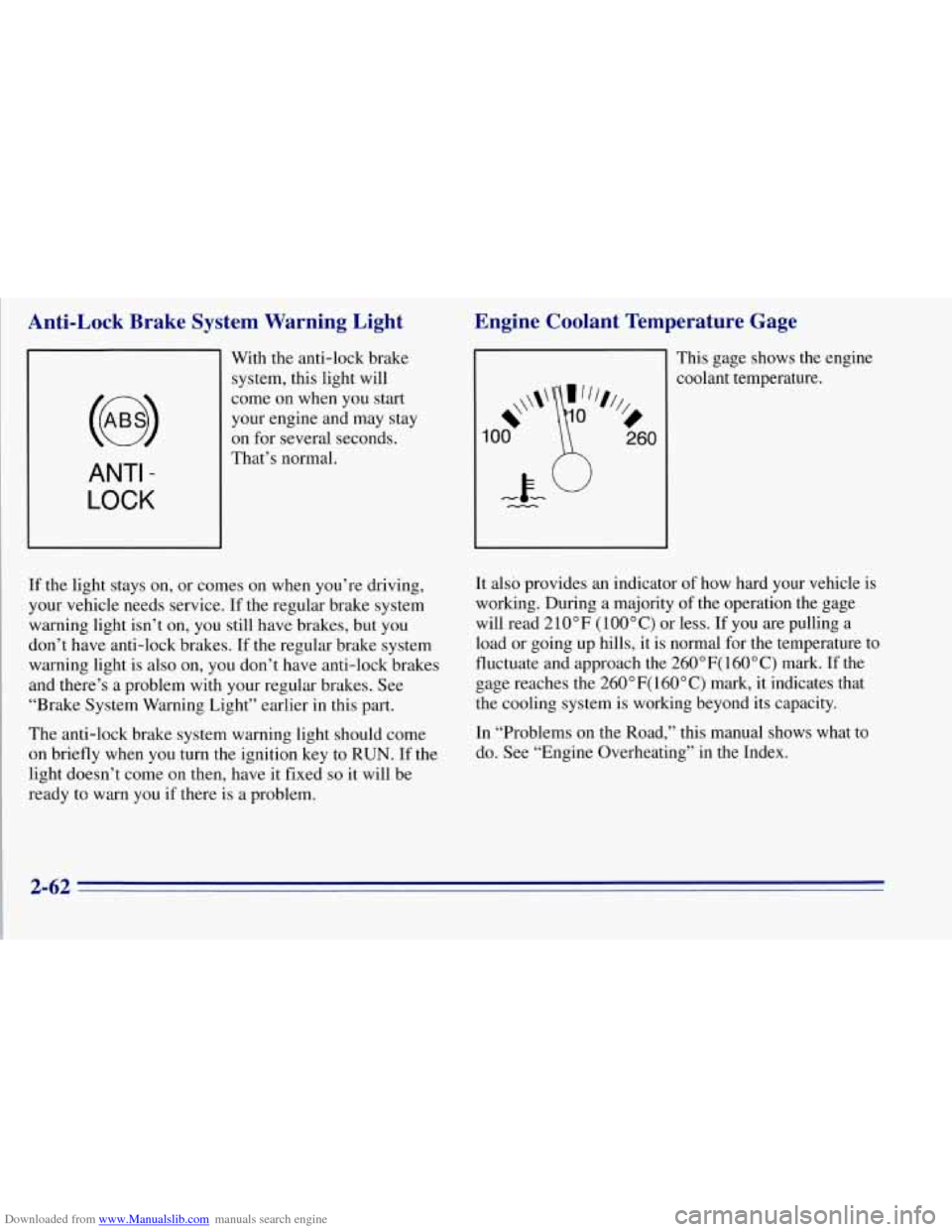
Downloaded from www.Manualslib.com manuals search engine Anti-Lock Brake System Warning Light
ANTI -
LOCK
With the anti-lock brake
system, this light will
come on when you start
your engine and may stay
on for several seconds.
That’s normal.
If the light stays on, or comes on when you’re driving,
your vehicle needs service. If the regular brake system
warning light isn’t
on, you still have brakes, but you
don’t have anti-lock brakes. If the regular brake system
warning light is also on, you don’t have anti-lock brakes
and there’s a problem with your regular brakes. See
“Brake System Warning Light” earlier in this part.
The anti-lock brake system warning light should come
on briefly when you turn the ignition key to RUN. If the
light doesn’t come
on then, have it fixed so it will be
ready to warn
you if there is a problem.
Engine Coolant Temperature Gage
This gage shows the engine
coolant temperature.
It also provides an indicator of how hard your vehicle is
working. During a majority of the operation the gage
will read 2
10 OF ( 100 ” C) or less. If you are pulling a
load or going up hills, it is normal for the temperature to
fluctuate and approach the 260”F( 160°C) mark. If the
gage. reaches the 260”F( 160°C) mark, it indicates that
the cooling system is working beyond its capacity.
In “Problems on the Road,” this manual shows what to
do. See “Engine Overheating” in the Index.
2-62
Page 180 of 403
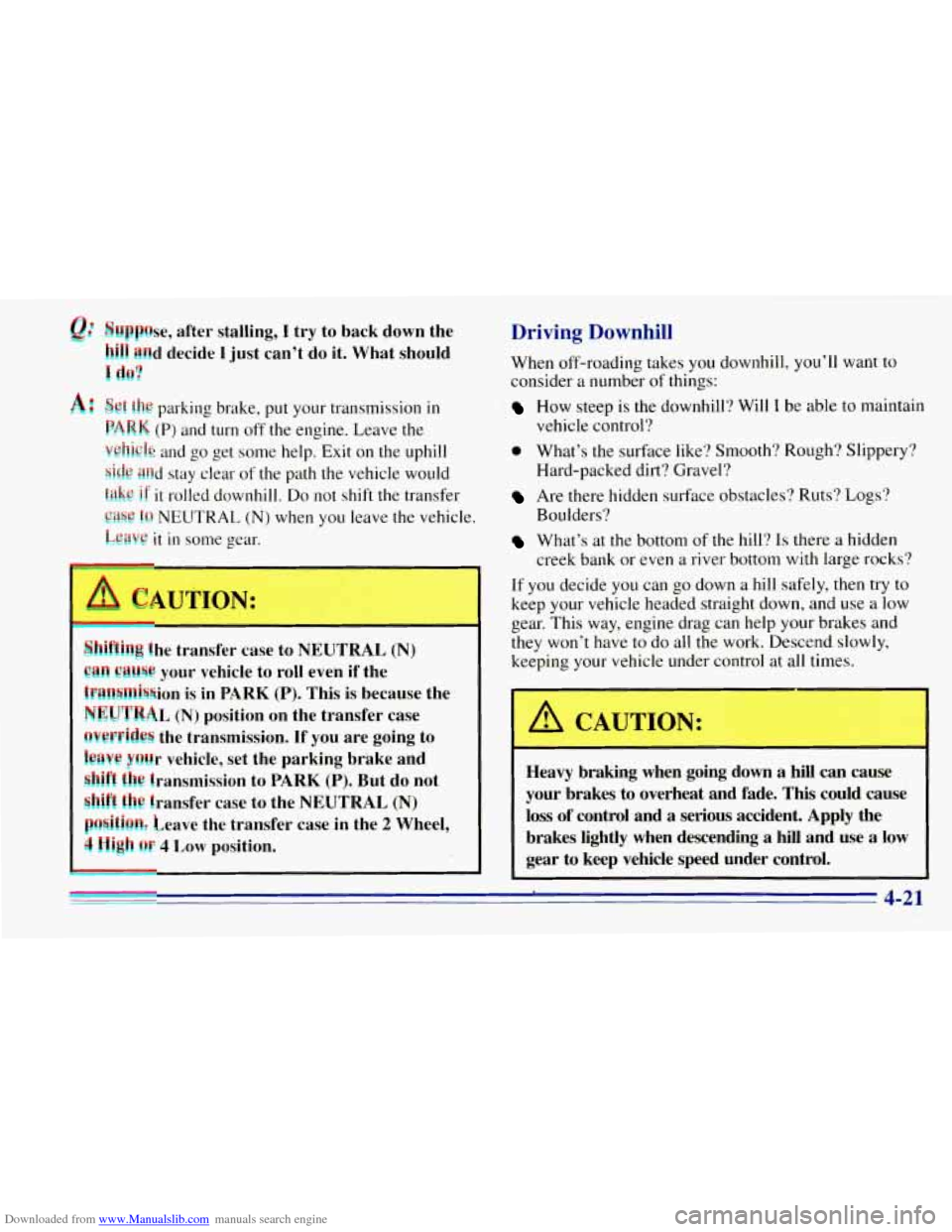
Downloaded from www.Manualslib.com manuals search engine Y Dppse, after stalling, I try to back down the
kill PRd decide I just can’t do it. What should
I d@7
A
!!kt €he parking brake, put your transmission in
PARK (P) and turn off the engine. Leave the
V@kk and go get some help. Exit on the uphill
.ri& gild stay clear of the path the vehicle would
tf it rolled downhill. Do not shift the transfer
*n NEUTRAL (N) when you leave the vehicle.
‘t in some gear.
$1 3 the transfer case to NEUTRAL (N)
BBH CiWslj@ your vehicle to roll even if the
fFtW8ftlj58ion is
in PARK (P). This is because the
NEuTuL (N) position on the transfer case
@V@PfkkS the transmission. If you are going to
hVf3 pi4r vehicle, set the parking brake and
hi! transmission to PARK (P). But do not
§hi## €hi! transfer case to the NEUTRAL (N)
pl iOR8 Leave the transfer case in the 2 Wheel,
4 1 ah 01: 4 LOW position.
Driving Downhill
When off-roading takes you downhill, you’ll want to
consider a number
of things:
How steep is the downhill? Will I be able to maintain
vehicle control?
0 What’s the surface like? Smooth? Rough? Slippery?
Hard-packed dirt? Gravel?
Are there hidden surface obstacles? Ruts? Logs?
Boulders?
What’s at the bottom of the hill? Is there a hidden
creek bank or even
a river bottom with large rocks?
If you decide you can
go down a hill safely, then try to
keep your vehicle headed straight down, and use a low
gear. This way, engine drag can help your brakes and
they won’t have to do all the work. Descend slowly,
keeping your vehicle under control at all times.
A CAUTION:
Heavy braking when going down a hill can cause
your brakes to overheat and fade.
This could cause
loss of control and a serious accident. Apply the
brakes lightly when descending
a hill and use a low
gear
to keep vehicle speed under control.
- 4-21